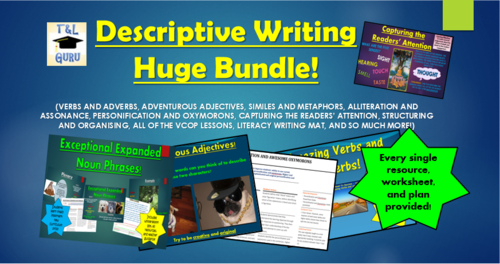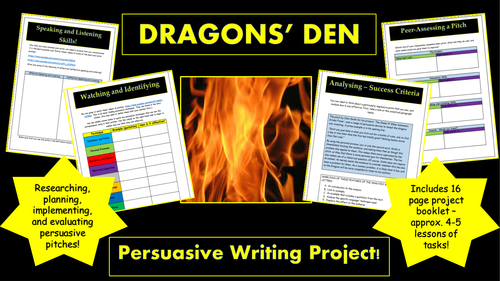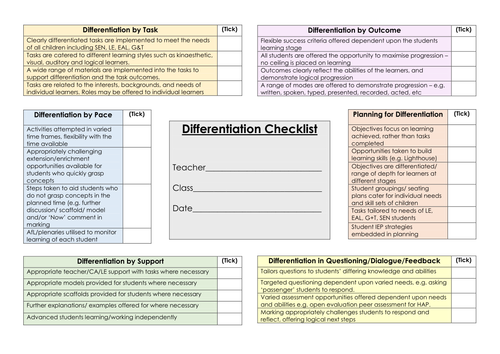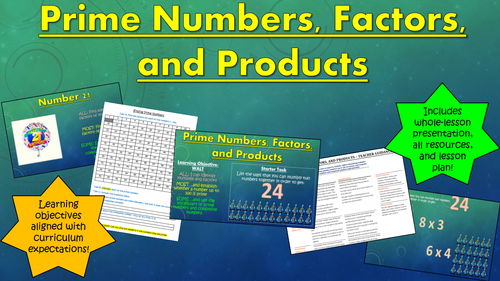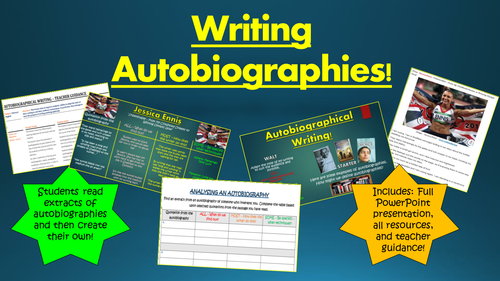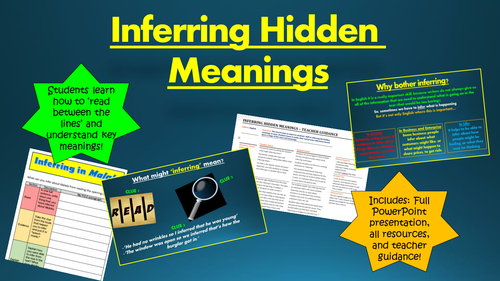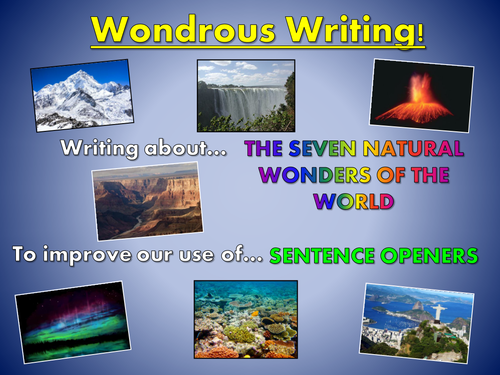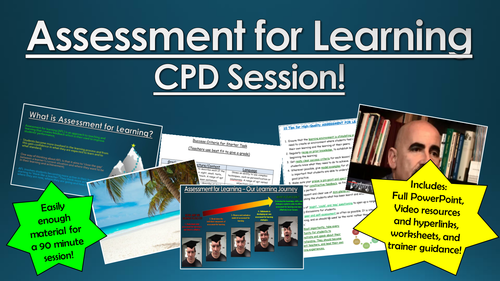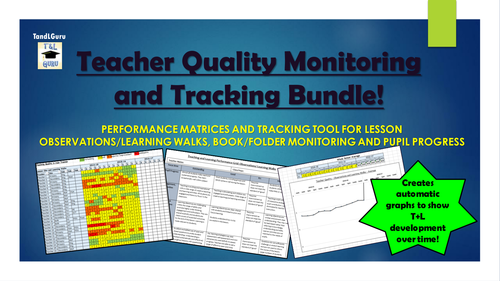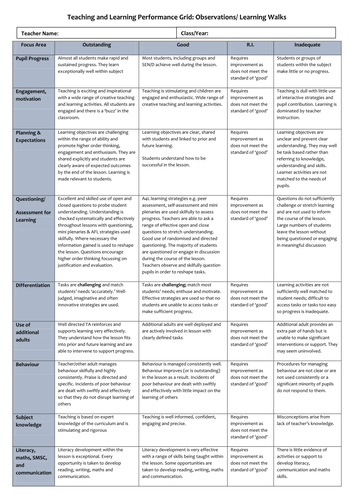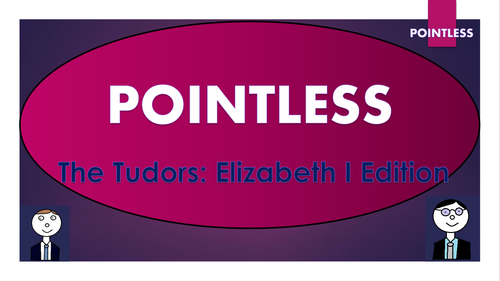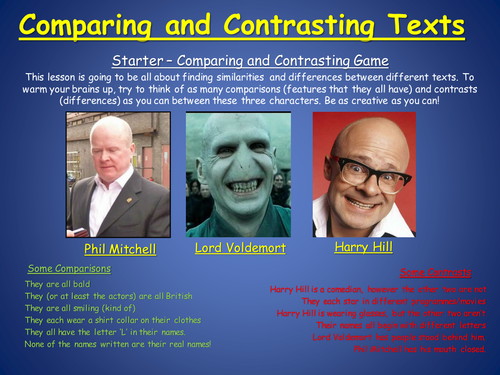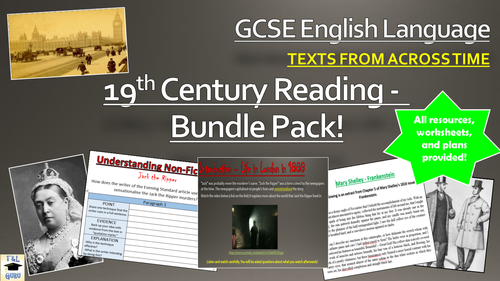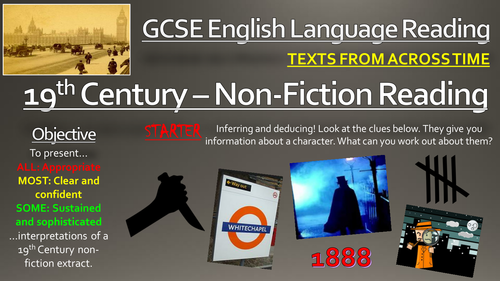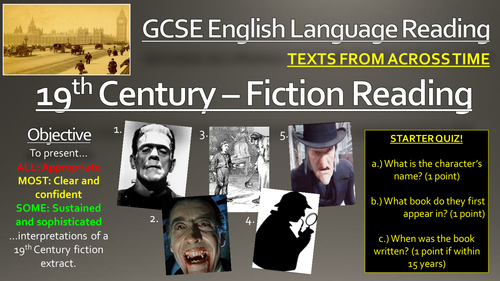
3k+Uploads
1967k+Views
2278k+Downloads
Pedagogy and professional development
Bundle

Descriptive Writing Huge Bundle! (All PowerPoints, Lesson Plans, Worksheets, Help-Sheets, Games, and More!)
This giant bundle pack offers a comprehensive range of descriptive writing lessons, (everything that you will need for them - whole lesson PowerPoints, worksheets, lesson plans - everything) help-sheets, writing templates, and activities.
Included are whole lesson resources (normally 2 pounds each) for:
-Amazing verbs and adverbs
-Adventurous adjectives
-Astonishing alliteration
-Capturing the readers' attention
-Exceptional expanded noun phrases
-Perfect personification and awesome oxymorons
-Structuring and organising creative writing
-Stupendous similes and miraculous metaphors
-Wondrous writing - seven wonders of the world
-Writing about Emotions
-VCOP - vocabulary
-VCOP - openers
-VCOP - connectives
-VCOP - punctuation
There are also a number of games and help-sheets, including:
- All 8 writing purpose help-sheets (Analyse, Explain, Inform, Persuade, Describe, Instruct, Evaluate, Argue)
- Literacy writing mat
-2 'Pointless' games
- Templates (Newspapers, Blogs, Postcards, etc.)
All images are licensed for commercial use and are cited on the final slides of the PowerPoints.

Dragons' Den Persuasive Project! (Building Speaking & Listening and Persuasive Writing Skills!)
This resource is perfect for enabling students to build both their persuasive writing and their speaking and listening skills. Based upon the popular BBC series 'Dragons' Den', students have the opportunity to research, design, pitch, and evaluate arguments for their own inventions, whilst simultaneously analysing persuasive pitches, revising persuasive techniques, structuring arguments and articulating convincingly.
Included is a 16 page booklet (I would say at least 4-5 hour lessons of tasks) that lead students to:
- Introduce themselves and their interests;
- Watch persuasive pitches (links included) and identify persuasive devices;
- Analyse why persuasive devices are effective;
- Structure an analysis appropriately;
- Brainstorm ideas for an invention using imagination and helpful aiding questions;
- Formulate an argument by considering key questions and counter arguments;
- Write and present a persuasive pitch;
- Peer-evaluate and self-evaluate persuasive pitches.
I have also provided some examples of news stories featuring the worst and best pitches from the den, in order to provoke discussion about what makes a strong pitch.
All images are licensed for commercial use and are cited throughout.

Writing Mats Big Bundle! (World Landscapes and Imagination Landscapes)
These original writing mats offer a varied and visually engaging way for students to independently increase the depth and breadth of their imaginative writing. Designed on A3, they simply need to printed and given to students before they begin creative writing tasks. They could also be used as colourful word posters to brighten up your classroom and familiarise children with new vocabulary.
The benefits of using these resources as writing mats is twofold: Firstly, the vibrant, wide-ranging, and student-friendly landscapes offer students a wealth of new writing stimuli. Secondly, the simple concrete noun labels save substantial learning time, as the effort that students may have previously exerted deliberating over the spellings of the common nouns is vastly reduced. Instead, students have the time to focus upon the teacher's intended key writing focus areas.
This bundle pack contains 12 'World Landscapes' writing mats, which draw on engaging images and key vocabulary from the following terrains:
-Rainforest
-Desert
-Under the Sea
-Safari
-Beach
-Farm
-Space
-Forest
-Town
-The Poles
-Park
-Mountain
In addition to this, there are 10 different imagination landscapes in this pack, many of which fit in with Primary/Early Secondary topics:
-Nightmare World
-Ancient Egypt
-Christmas
-Medieval Times
-The Future
-Pirates
-Olympics
-Romans
-The Circus
-Fairy Tales
Every image used in this resource pack is licensed for commercial use, and all are cited on separate documents within the pack.
Alternatively, the 'World Landscapes' and 'Imagination Landscapes' packs can be purchased separately for 2 pounds each.

Learning Walk/ Teacher Development Checklists
These comprehensive checklists have been created to aid school leaders when performing learning walks with a particular focus e.g. questioning, differentiation, etc. Clearly structured and organised, they present a central idea surrounded by a breakdown of a number of its key components.
For the user, this layout provides a simple reference list of each of the desirable skills, categorised appropriately. The checklists also provide an alternative to regular feedback methods, which often focus too heavily on the standard or ‘judgement’, as opposed to being a developmental tool.
Alternatively, these are really handy for teachers looking to develop their practice in the key teaching areas listed below. Included in the pack are checklists for:
-Questioning
-Differentiation
-Utilising Resources (including support staff)
-Engagement
-Building Literacy Skills
-Planning and Expectations
-Building Learning Power
-A blank template for you to design your own based upon your own focus
Note: The checklists offer a range of desirable strategies that teachers should look to implement over time - it would be damaging to expect teachers to utilise each of these strategies in every lesson!
Many Thanks

Prime Numbers, Factors, and Products
This engaging and informative set of resources aids students in developing an understanding of prime and composite numbers. Throughout the lesson, students improve their skills at identifying multiples and factors, establishing whether numbers up to 100 are prime, and using the vocabulary of prime numbers and composite numbers appropriately.
The well-presented presentation and lesson plan guides learners and teachers through several different tasks, including:
- Defining and identifying the key terms: Prime Number, Composite Number, Factor, and Product;
- Applying their understanding of these key terms to individual numbers, and then numbers up to 100;
- Finding and describing patterns that they find when establishing prime and composite numbers;
- Researching and writing about the prime or composite state of numbers of their choice;
- Peer-assessing the learning of other students against the lesson objectives.
Included in this pack are:
- A colourful and information-loaded whole-lesson PowerPoint presentation;
- Activity cards for the starter task;
- A comprehensive worksheet for the main task;
- A detailed lesson plan
All images are licensed for commercial use and are cited on the final slide.

Writing Autobiographies!
This stimulating and informative lesson aims to improve students’ ability to adapt the style of their writing to suit their audience and purpose. In particular, they attempt to meet the purpose of writing autobiographically.
Students follow a clear and logical learning journey, in which they:
-Define autobiographies and their key features;
-Read extracts of autobiographies, and analyse the language techniques used;
-Use independent learning skills to analyse an autobiography of their choice;
-Create a success criteria for effective autobiography writing (although a ready-made success criteria is included)
-Write a section of their own autobiography, using the techniques that they have learnt;
-Peer/self-assess their autobiographical attempts.
There are enough resources here really for two lessons, including:
-Visually engaging whole-lesson PowerPoint;
-Autobiography extract;
-Analysing Autobiographies template;
-Success Criteria;
-Step-by-step lesson plan.
All images are licensed for commercial use, and are cited on the final page of the slide.

Inferring the Hidden Meanings in Texts
This lesson enables students to 'read between the lines' in texts and infer significant meanings. Utilising a range of visual, kinaesthetic, and reading tasks, students not only gain an increased understanding of the importance of inference in English, but also gain an awareness of its importance in other areas of life.
The lesson follows an interesting and engaging step-by-step learning journey, which helps students to:
- Define what inference is;
- Understand the importance of inference;
- Infer what they can see;
- Infer what they hear;
- Infer what they read, using key sentence starters and textual evidence;
- Formulate P.E.E. inference responses, where necessary utilising the included scaffolds and help-sheets;
- Peer/self assess their learning attempts.
Included in this resource pack:
- Full whole-lesson PowerPoint presentation;
- P.E.E scaffold sheet;
-Writing to analyse helpsheet;
- Pictures required for development task;
- Teacher guidance
All images are licensed for commercial use, and are cited on the final slide.

Wondrous Writing! Seven Wonders of the World - Sentence Openers
Wondrous Writing is an interesting and effective way to enable young people to build their writing skills. Focussing on one key writing skill, students compose sentences during timed intervals, using picture prompts as inspiration. This aids them in constructing a larger, more substantial piece of writing over the course of the lesson. Assessment for Learning is utilised throughout, with success criterias provided for students to peer/self assess both before and after the main task.
The focus for this lesson is sentence openers - utilising the topic of 'The Seven Wonders of the World.' Included in this pack is:
- Whole lesson PowerPoint, complete with visual stimuli for writing;
- Hyperlink to stopwatch app;
- Writing Template
- Writing to Describe Help-sheet
- Success Criteria - Peer/Self-Assessment Form

George's Marvellous Medicine - Assorted Resources! (Worksheets, PowerPoints, Assessments etc.)
This pack contains a vast number (I think there's about 20 resources here) of activities, resources, and ideas for the teaching of Roald Dahl's 'George's Marvellous Medicine.' They should provide an excellent starting point for anybody who wants to teach the book and is looking for some inspiration for individual lesson content/ tasks. The vast majority of these tasks can be adapted for differing age groups/ ability ranges/ needs.
The pack contains resources that focus on the key themes in the book, such as family and emotions. There are also resources that enable to build individual reading skills, such as inferring and deducing, pulling out quotations, and analysing language. In writing, students learn to think imaginatively and create texts appropriate to audience and purpose.
All images are licensed for commercial use, and are cited on the final slides of the PowerPoints.

Out of the Blue - Simon Armitage - 9/11 Poem
These informative and engaging resources enable students to build the skills needed to interpret and analyse the langauge used in poems. These resources also give students a strong foundation knowledge, including the SMSC implications, of the events of 9/11 - an important historical day that should never be forgotten.
Students learn through the following tasks:
- Collecting and discussing knowledge of the events of the day through an interactive starter task;
- Reading the poem 'Out of the Blue' and identifying the descriptive devices throughout the poem;
- Discussing a model analytical paragraph about the language used in the poem, in order to form their own success criteria;
- Using a template to form their own analytical paragraphs about the language used in the poem;
- Using peer or self-assessment in order to establish their success at analysing language.
The following resources are provided:
- Engaging and colourful step-by-step PowerPoint
- Poem
- Teacher lesson guidance;
- Identifying worksheet;
- Analysis template;
- Writing to analyse help-sheet
- Analysis model
All images are licensed for commercial use, and are cited on the final slide of the PowerPoint.

Assessment for Learning CPD Session!
This CPD session offers an engaging and original approach to introducing or revisiting assessment for learning. Grounded in educational research, this CPD session is interactive, well-structured, and has been successfully tried and tested. The aim of the CPD session is to develop the knowledge, skills, and strategies needed in order to utilise assessment for learning even more effectively in lessons, and it achieves this by embarking upon the following learning journey:
1. Understand what assessment for learning is and why it is effective.
2. Break down the individual components of assessment for learning.
3. Observe and evaluate a model of assessment for learning
4. Collaborate in developing your own assessment for learning strategies.
Included in this pack are: Full PowerPoint presentation, videos for analysis, hyperlinks to Youtube videos, resources for CPD activities, instructions and guidance for trainers/ presenters.
All images and videos are licensed for commercial use, and are cited on the final slide.

Teacher Quality Monitoring and Tracking Big Bundle!
Contained in this bundle are all of the teacher performance grids, (lesson observations, book monitoring, and pupil progress) in addition to the teacher quality trackers. Used in combination, these resources enable school leaders and data managers to easily and precisely monitor teacher quality over time.
The Teacher Performance Grids contain:
1.) Observation & Learning Walk Performance Grid
2.) Marking and Feedback Performance Grid
3.) Pupil Progress Performance Grid
For use alongside lesson observations, learning walks, book monitoring, and discussions about pupil progress, these succinct performance grids enable observers to gauge, categorise, and feedback on teaching and learning using OFSTED guidance for effective teaching. The documents provide descriptors of 'outstanding', 'good', 'requires improvement' and 'inadequate' practice within appropriately considered teaching and learning focus areas, for example: Questioning, Positive Feedback, Use of Additional Adults, Noticing Data Trends and Plotting Interventions etc. Schools who opt to grade individual teachers on their performance have noted that these are helpful aids in arriving at an overall judgement.
The Teacher Quality Trackers allow teaching and learning leaders to monitor the quality of teaching across their departments/ schools over time, focusing on the triangulated performance indicators of: Lesson Observations/Learning Walks, Book/Folder Monitoring, and Pupil Progress. Users can easily view changes in individual, department, key stage, and whole school teaching and learning quality over time.
The tools are automatically formatted to colour code entries from the codes 1 (Outstanding = Green) to 4 (Inadequate = Red) Each entry also updates the 'average school performance' table, which in turn alters the line graph showing quality over time. This enables leaders to easily identify trends in performance data. Furthermore, there is also space in which users can give details of CPD sessions and interventions, in order to a provide a foundation to evaluate their impact.
Individual pages are provided for observations, book monitoring, and pupil progress.
'3 captures per year' and '6 captures per year' versions are provided, to allow for schools that measure quality at variable intervals.

Teacher Quality Tracking System
These well-designed, easy to use teacher quality trackers allow teaching and learning leaders to monitor the quality of teaching across their departments/ schools over time, focusing on the triangulated performance indicators of: Lesson Observations/Learning Walks, Book/Folder Monitoring, and Pupil Progress. Users can easily view changes in individual, department, key stage, and whole school teaching and learning quality over time.
The tool is automatically formatted to colour code entries from the codes 1 (Outstanding = Green) to 4 (Inadequate = Red) Each entry also updates the 'average school performance' table, which in turn alters the line graph showing quality over time. This enables leaders to easily identify trends in performance data. Furthermore, there is also space in which users can give details of CPD sessions and interventions, in order to a provide a foundation to evaluate their impact.
Individual pages are provided for observations, book monitoring, and pupil progress.
'3 captures per year' and '6 captures per year' versions are provided, to allow for schools that measure quality at variable intervals.

Triangulation of T+L Quality: Grids for Observations, Book Monitoring, and Pupil Progress
This resource pack is comprised of:
1.) Observation & Learning Walk Performance Grid
2.) Marking and Feedback Performance Grid
3.) Pupil Progress Performance Grid
For use alongside lesson observations, learning walks, book monitoring, and discussions about pupil progress, these succinct performance grids enable observers to gauge, categorise, and feedback on teaching and learning using OFSTED guidance for effective teaching. The documents provide descriptors of 'outstanding', 'good', 'requires improvement' and 'inadequate' practice within appropriately considered teaching and learning focus areas, for example: Questioning, Positive Feedback, Use of Additional Adults, Noticing Data Trends and Plotting Interventions etc. Schools who opt to grade individual teachers on their performance have noted that these are helpful aids in arriving at an overall judgement.

Pupil Progress Performance Grids
For use alongside data captures and discussions about pupil progress, this succinct performance grid enables observers to gauge and categorise department and individual teacher approaches to pupil progress data, using OFSTED guidance. The first page of the document provides descriptors of 'outstanding', 'good', 'requires improvement' and 'inadequate' feedback within appropriately considered focus areas, for example: Rate of Progress, Accuracy, Noticing Trends and Plotting Interventions, etc. Schools that already employ this tool often opt to highlight the descriptors on this page as they complete the scrutiny, thus creating a bigger picture of the strengths and areas for improvement observed. This can also be a helpful aid in arriving at an overall judgement, should your school opt to arrive at one. The second page allows observers to further pinpoint and describe the 'www' (what went well) and 'ebi' (even better if) aspects of the feedback, to aid teacher/department in improving their practice.

Pointless - History Bundle Pack - The Tudors (3 full games included!)
Based on the popular game show 'Pointless', these resources are perfect for use as a starter activity, plenary, or revision tool. Editable, so that you can change to any other topic or change the questions/answers. Containing sound clips, engaging visuals, and suitably challenging questions, these resources are effective at both promoting engagement and enhancing learning.
There are three fully functional and challenging games, including:
- The Tudors (easier)
- Henry VIII (intermediate)
- Elizabeth I (more difficult)
Each game contains four full rounds, which are fun, interesting, and promote deeper thinking in students.
The nature of the game ensures that this resource can challenge students of all levels.

New GCSE English Language - Comparing and Contrasting
This informative and engaging double lesson aims to improve students’ ability to compare and contrast two different texts based on a similar subject. They will focus particularly on the purpose, audience, language, and structure of texts, and will learn to use comparing and contrasting connectives to highlight any similarities and differences. This has always been a crucial skill in English, but has an increased importance in the new GCSE for English Language, as there is a greater requirement for students to be able to make links and comparisons between texts.
The lesson follows a clear and logical learning journey, with students learning to:
- Understand the key terms 'compare' and 'contrast', and the importance of these skills in English;
- Categorise the different features that they can compare, under the headings 'Purpose', 'Audience', 'Language' and 'Structure;'
- Read (and identify the key features within) two morally and ethically intriguing texts, offering diverse views of young people in the media;
-Compare the two texts, using a clear and concise template, and newly-acquired knowledge of different types of connectives;
- Peer-assess each other's comparative essay attempts.
Included in this resource pack are:
- Whole double lesson, colourful and engaging PowerPoint presentation (Including assessment for learning referral slides)
- Cards for card-sorting activity;
- Two interesting and thought-provoking non-fiction media extracts (one a newspaper extract from The Evening Standard, and another a persuasive leaflet, both focused on the issue of how young people are perceived.)
- Template for main comparative analysis task;
- Full teacher guidance plan.
All images are licensed for commercial use and are cited on the final slide of the PowerPoint presentation

New GCSE English Language Reading: 19th Century Bundle Pack! (Context, Fiction, Non-Fiction)
This bundle contains all of the resources for:
- New GCSE English Language Reading: 19th Century Context; New GCSE English Language Reading: 19th Century Fiction; New GCSE English Language Reading: 19th Century Non-Fiction.
These informative and engaging lessons enable students to build the skills needed to interpret and analyse 19th Century non-fiction texts. This will aid students through the new GCSE English Language - for which they need to become confident readers of 19th, 20th, and 21st Century fiction and non-fiction texts. These resources give students a strong foundation of knowledge of features of fiction and non-fiction texts in the 19th Century, using a range of visual and varied resources. There are easily enough resources for at least two lessons within this resource pack.
The following resources are provided:
- Engaging and colourful step-by-step PowerPoint presentations;
- Visually engaging worksheets;
- Resources for all activities;
- Writing purposes help-sheet, to aid longer writing tasks;
- All Lesson plans;
All images are licensed for commercial use, and are cited on the final slide of each PowerPoint. These lessons can also be bought individually - priced at £2.00 each

New GCSE English Language Reading: 19th Century Non-Fiction
These informative and engaging resources enable students to build the skills needed to interpret and analyse 19th Century non-fiction texts. This will aid students through the new Paper 2 Section A of GCSE English Language - for which they need to become confident readers of 19th, 20th, and 21st Century non-fiction texts. These resources give students a strong foundation of knowledge of features of non-fiction texts in the 19th Century, using newspaper stories from the time based on 'Jack the Ripper' as the predominant examples. There are easily enough resources for at least two lessons within this resource pack.
Students learn through the following tasks:
- Inferring and deducing contextual knowledge through an interactive starter task;
- Understanding the features of London in 1888 through a video introduction;
- Building close reading skills through a study of a non-fiction extract about Jack the Ripper;
- Answering exam-style questions interpreting and inferring the key meanings in the text;
- Using models and templates to write extended analysis responses about the language used in the non-fiction extract;
- Peer assessing their partners' learning attempts.
The following resources are provided:
- Engaging and colourful step-by-step PowerPoint;
- Jack the Ripper newspaper extract;
- Teacher lesson guidance;
- Interpretation worksheet;
- Analysis worksheet;
- Writing to analyse.
All images are licensed for commercial use, and are cited on the final slide of the PowerPoint.

New GCSE English Language Reading: 19th Century Fiction
These informative and engaging resources enable students to build the skills needed to interpret and analyse 19th Century fiction texts. This will aid students through the new Paper 1 Section A of GCSE English Language - for which they need to become confident readers of 19th, 20th, and 21st Century texts. These resources give students a strong foundation of knowledge of features of fiction texts in the 19th Century, using Mary Shelley's Frankenstein as the predominant example. There are easily enough resources for at least two lessons within this resource pack.
Students learn through the following tasks:
- Gauging and collaborating previous knowledge through an interactive starter task;
- Identifying the descriptive devices in sentences written about 19th Century characters;
- Building close reading skills through a study of a fiction extract from Frankenstein
- Answering exam-style questions interpreting and inferring the key meanings in the text;
- Using models and templates to write extended analysis responses about the descriptive language used in the fiction extract;
- Peer assessing their partners' learning attempts.
The following resources are provided:
- Engaging and colourful step-by-step PowerPoint
- Frankenstein extract
- Teacher lesson guidance;
- Interpretation worksheet;
- Analysis worksheet;
- Writing to analyse help-sheet
All images are licensed for commercial use, and are cited on the final slide of the PowerPoint.

